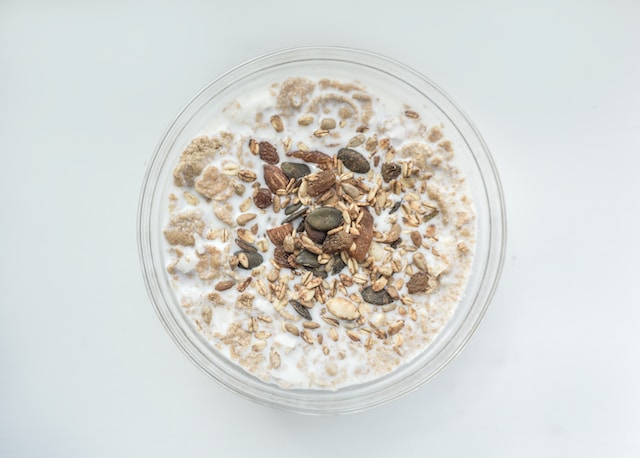Oat milk is a popular dairy-free milk alternative that is enjoyed by many people. It is made by blending soaked oats with water and then straining the mixture to remove any solids. Oat milk has a creamy texture and a slightly sweet taste, making it a great addition to coffee, smoothies, and cereal.
One question that many people have is whether or not oat milk can be frozen. The answer is yes, oat milk can be frozen.
Freezing oat milk is a great option if you have an opened package of oat milk that you don’t think you’ll be able to finish before it goes bad.
It is also a great way to stock up on oat milk so that you always have some on hand when you need it.

However, there are some important things to keep in mind when freezing oat milk. It is important to leave enough room at the top of the container to allow for expansion as the liquid freezes.
It is also important to properly thaw the oat milk before using it to ensure that it retains its texture and flavor. In this article, we will explore the best way to freeze oat milk and provide tips on how to properly thaw it for optimal results.
Contents
Freezing Oat Milk: Pros and Cons
Freezing oat milk is a great way to extend its shelf life and reduce waste. Here are some pros and cons to consider:
Pros
- Longer shelf life: Freezing oat milk can extend its shelf life up to 6 months.
- Convenient: Freezing oat milk is a convenient way to have it on hand when you need it.
- Cost-effective: Freezing oat milk can help you save money by reducing waste.
Cons
- Texture changes: Freezing and thawing oat milk can cause changes in texture, making it less creamy and smooth.
- Separation: Freezing oat milk can cause it to separate, requiring it to be shaken or stirred before use.
- Flavor changes: Freezing oat milk can also cause changes in flavor, making it less enjoyable to drink.
Overall, freezing oat milk can be a useful solution for extending its shelf life and reducing waste. However, it’s important to consider the potential changes in texture and flavor that may occur. If you decide to freeze your oat milk, be sure to follow the proper storage and thawing procedures to minimize these effects.
How to Freeze Oat Milk
Freezing oat milk is a simple process, and it can be done in a few easy steps. Here’s how:
- Pour the oat milk into an airtight container. Make sure to leave some room at the top to allow for expansion during freezing.
- Label the container with the date so you can keep track of how long it has been in the freezer.
- Place the container in the freezer and allow it to freeze completely.
When you’re ready to use the frozen oat milk, follow these steps:
- Remove the container of frozen oat milk from the freezer and place it in the fridge to thaw. This will take several hours, so it’s best to do this overnight.
- Once the oat milk has thawed, give it a good shake or stir to help restore its original consistency.
- Use the thawed oat milk as you normally would.
It’s important to note that frozen oat milk may have a slightly grainy texture once it has been thawed. However, this shouldn’t affect its taste or quality.
Also, keep in mind that frozen oat milk should be used within 6 months for best results. After that, it may start to lose its flavor and quality.
Thawing and Using Frozen Oat Milk
Thawing frozen oat milk is a simple process. You can either place the frozen oat milk in the refrigerator for at least 8 hours or overnight until it is fully thawed or leave it at room temperature for a few hours until it reaches room temperature.
Once the oat milk is thawed, it may have changed in consistency slightly, but this is normal and does not affect its taste or nutritional value. You can use it as you would normal oat milk.

It is important to note that once oat milk is thawed, it should be consumed within a few days. Do not refreeze thawed oat milk, as this can cause it to spoil and become unsafe to consume.
If you have a large amount of frozen oat milk, consider portioning it into smaller containers before freezing. This will make it easier to thaw only the amount you need and reduce waste.
In summary, thawing and using frozen oat milk is a simple process. Thaw it in the refrigerator or at room temperature, and use it within a few days once it is thawed. Consider portioning it into smaller containers before freezing to reduce waste.
FAQs
Here are some frequently asked questions about freezing oat milk:
Can oat milk be frozen?
Yes, oat milk can be frozen. Freezing is an excellent way to extend the shelf life of oat milk and avoid wasting it. However, it’s vital to follow the proper storage techniques to ensure that the oat milk stays fresh and safe to consume.
How long can you freeze oat milk?
Oat milk can be frozen for up to six months. However, it’s best to consume it within 10 days after thawing to ensure that it’s still fresh and safe to consume.
What’s the best way to freeze oat milk?
The best way to freeze oat milk is to pour it into a freezer-safe container and leave at least one inch of space at the top. Oat milk expands as it freezes, so it’s essential to leave enough room to prevent the container from breaking. You can also freeze it in the carton if it hasn’t been opened yet.
How do you thaw frozen oat milk?
To thaw frozen oat milk, remove it from the freezer and let it thaw in the refrigerator for a few hours or overnight. If you’re in a hurry, you can place the container in a warm bowl of water for about 20 minutes. Once thawed, shake or stir the oat milk thoroughly to restore its texture.

